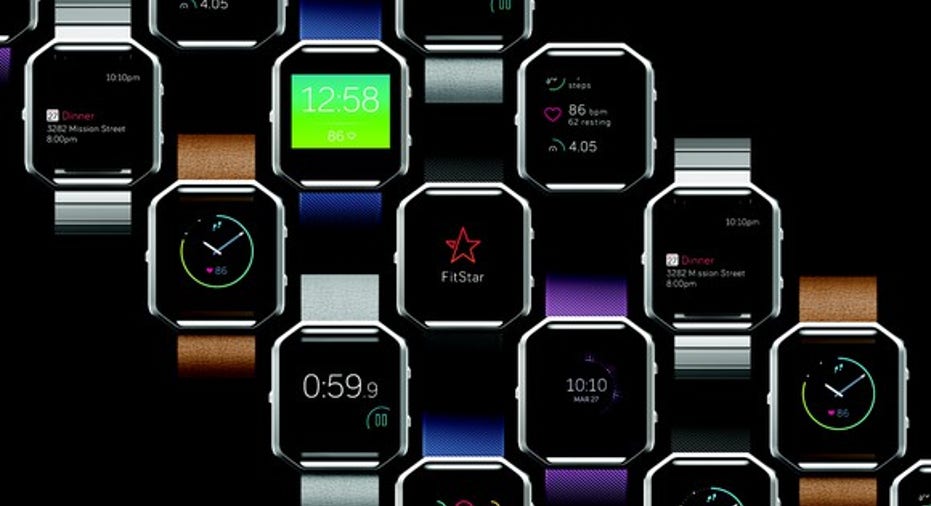Can Fitbit Inc. Bounce Back After Falling 50% in 2016?

Shares of Fitbit (NYSE: FIT) have fallen 50% this year because of slowing sales, rising competition, and falling margins. The Blaze and Alta posted robust sales earlier this year with a million shipments each during thefirst month, but the reception for the new Charge 2 has been much cooler.
Charge 2. Image source: Fitbit.
The $150 device was initially met with mixed reviews after its launch in August. CNET called itthe "best Fitbit of the bunch," but The Verge complained that itwas "plagued by bugs." Pacific Crest analyst Brad Erickson recently warned that his retail checks found "more than two weeks of inventory" for the Charge 2, indicating that its run rates were "below where Blaze and Alta began earlier this year" and indicating "a disappointing start" for the new device.
Should investors heed Erickson's warning and avoid Fitbit? Or will its sales accelerate into the holiday season and finally help the stock bounce back?
Why Fitbit could sink
At first glance, Fitbit's 46% year-over-year sales growth lastquarter looks robust. However, the company expects its sales to rise only 34% to 40% this year, compared with 149% growth in 2015. Fitbit couldn't post triple-digit sales growth forever, but investors are also concerned about Fitbit's margins. Its non-GAAP gross margin fell 520 basis points annually to 42% last quarter, while its operating margin plunged from 20% to less than 2%.
That decline was caused by aggressive investments in R&D, sales, and marketing for new products such as the Blaze and Alta. As a result, Fitbit expects its non-GAAP earnings to improve only 5% to 16% this year, compared with 91% growth in 2015. Analysts, on average, expect Fitbit's annual earnings toimprove 10%.
Blaze. Image source: Fitbit.
The main problem is that Fitbit must keep spending heavily to widen its moat against the competition. Appledominates the high-end smartwatch market, Xiaomi and other cheaper rivals are advancing in the low-end market, and sports performance players such as Garminare flooding the market with all sorts of wearables for different activities. If Fitbit's sales continue slowing down and it responds by lowering prices and spending more, it could get stuck in a cycle of widening losses.
Why Fitbit might rise
Despite all the pessimism about Fitbit's future, its market share is holding steady as it grows its shipments year-over-year. IDC recently reported that Fitbit's market share rose from 24.9% to 25.4% between the second quarters of 2015 and 2016, preserving its crown as the top wearables maker in the world.
Shipments also rose 28.7% annually to 5.7 million units, thanks to the introduction of new devices such as the Blaze and Alta. IDC believes that new devices such as the Charge 2 and Flex 2 indicated that the company was "growing up" by "giving form and function equal importance." That growth in market share and shipments indicates that Fitbit still has tremendous brand strength -- which could hold its rivals at bay.
Flex 2. Image source: Fitbit.
Instead of competing directly against Apple or Xiaomi, Fitbit has pivoted toward mid-range devices that lack many higher-end smartwatch functions but pack in plenty of fitness features such as heart rate tracking and the identification of different workouts. Unlike the Apple Watch, which has less than a full day of battery life, the Charge 2, Flex 2, Alta, and Blaze all last for up to five days on a single charge.
That means Fitbit could continue dominating the niche for premium fitness trackers, where its only meaningful rival is Garmin. Fitbit is also gradually expanding its ecosystem with enterprise wellness programs and mobile payments.
Lastly, Fitbit is fairly cheap relative to its growth and trades at a 25% discount to its IPO price of $20. Analysts currently expect the company to post an average of 20% annual earnings growth over the next five years, which gives the stock a five-year PEG ratio of 0.6. Since a PEG ratio under 1 is considered a mark of being undervalued, Fitbit looks very cheap relative to its earnings growth potential.
The verdict: Avoid Fitbit ... for now
I believe that Fitbit's market share and sales growth look solid, but the company must get its expenses under control and show that new products such as the Charge 2 can capture new customers. If it can accomplish those two things, I'd consider buying Fitbit as a value play. But for now, I'll simply keep a close eye on the stock.
A secret billion-dollar stock opportunity The world's biggest tech company forgot to show you something, but a few Wall Street analysts and the Fool didn't miss a beat: There's a small company that's powering their brand-new gadgets and the coming revolution in technology. And we think its stock price has nearly unlimited room to run for early in-the-know investors! To be one of them, just click here.
Leo Sun has no position in any stocks mentioned. The Motley Fool owns shares of and recommends Apple and Fitbit. The Motley Fool has the following options: long January 2018 $90 calls on Apple and short January 2018 $95 calls on Apple. Try any of our Foolish newsletter services free for 30 days. We Fools may not all hold the same opinions, but we all believe that considering a diverse range of insights makes us better investors. The Motley Fool has a disclosure policy.